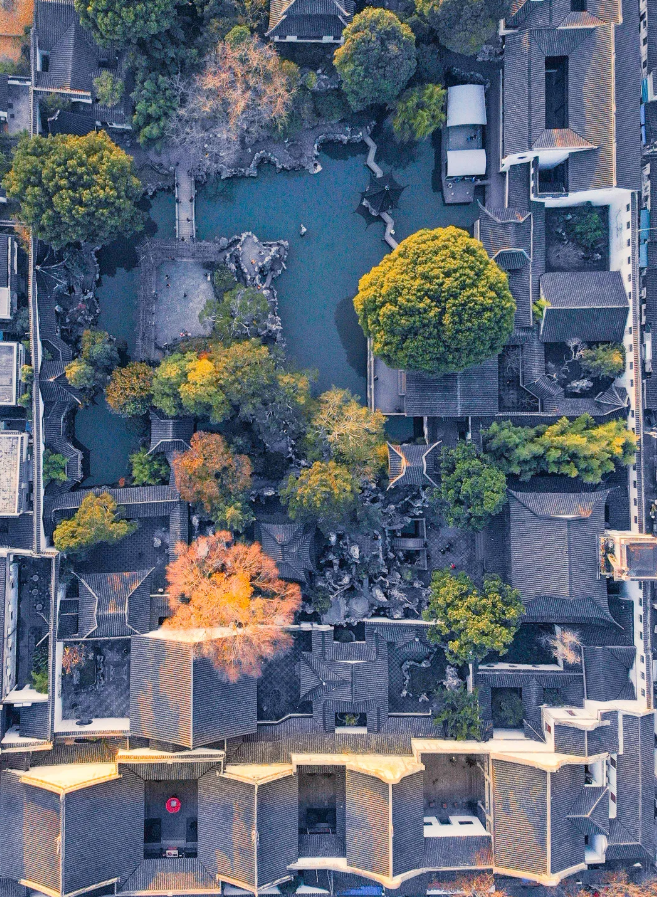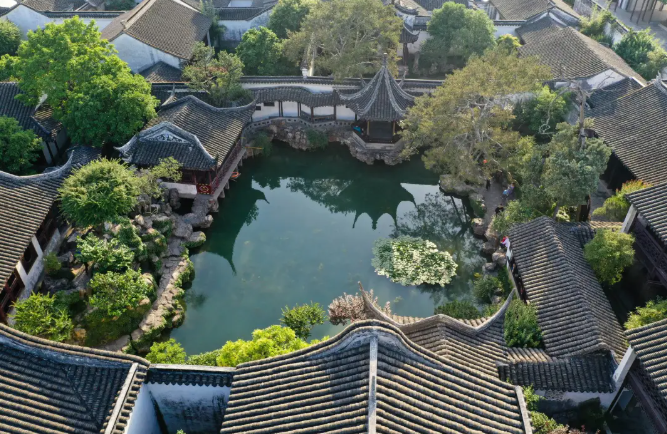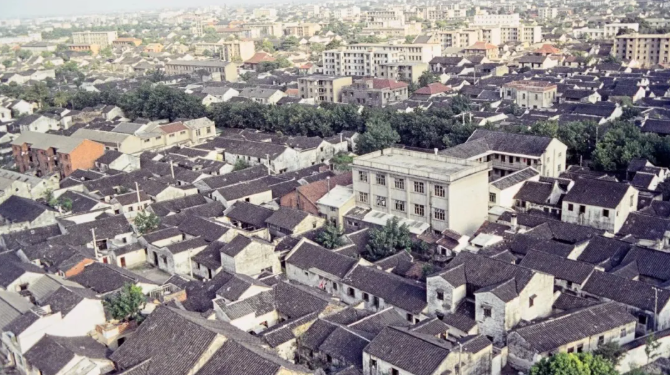“Above, there is Heaven; below, there is Suzhou and Hangzhou.” This saying has long captivated many with its poetic charm, making people yearn for the scenic beauty of Suzhou and Hangzhou. In 1982, Suzhou, captured through a camera lens, appeared ancient and serene, almost like an old, quiet town frozen in time.
In the realm of traditional Chinese gardens, Jiangnan gardens are regarded as the finest in the world, with Suzhou gardens standing as the epitome of excellence in the region. Suzhou’s gardens are renowned not only for their delicate artistry but also for their ability to craft expansive landscapes within a confined space. These gardens transform a limited area into a stunning three-dimensional landscape, bringing the vastness of nature into a small realm. This artistic achievement is perhaps best described as a miniature universe within a few steps.

The core principle of Suzhou gardens lies in their artistic arrangement—transforming nature’s grandeur into a harmonious and intricately detailed miniature world. The charm of Suzhou gardens is not simply in their appearance but in their creation of an immersive experience. The ability to bring a sense of limitless space into a limited area is an achievement that requires profound artistic skill.
Most of Suzhou’s classical gardens were designed with a focus on the aesthetic and philosophical ideals of scholars, and the historical rise of these gardens cannot be separated from the literary culture of the time. In ancient China, many scholars, either dismissed or retired, dreamed of escaping to the tranquil beauty of nature. They yearned for a life away from the hustle of the world, filled with poetic inspiration. However, reality often kept them in the mundane, forcing them to carve out a corner of nature within the confines of the ordinary world. Suzhou, located far from the political centers, became the ideal place for these scholars to retreat.
Suzhou, situated in the fertile land of the Yangtze River Delta, is ideally positioned for the growth of a wide variety of plants. To the west lies Taihu Lake, famous for producing Taihu stones that are perfect for creating delicate, intricate rockeries—one of the distinctive features of Suzhou gardens. The city is also crisscrossed by the Grand Canal, a major waterway that runs north to south and historically supported a vibrant trade economy. This combination of geographical advantages, economic prosperity, and abundant natural resources gave birth to the cultural flourishing captured by the famous saying: “Above, there is Heaven; below, there is Suzhou and Hangzhou.”

Aside from geography and economy, Suzhou’s long-standing tradition of cultural excellence played a significant role in the rise of its gardens. Throughout history, the city has been home to many renowned artists, scholars, and craftsmen. The Wu School of painting, for instance, greatly influenced garden design. These painters believed in incorporating their artistic compositions into the design of gardens, creating a harmonious union between painting and landscape design. As the garden-building and architectural industries flourished, organizations like the “Xiangshan Gang,” a group of skilled architects, contributed significantly to the preservation and growth of Suzhou’s garden culture. The traditions and techniques of garden building and craftsmanship have been passed down through generations, remaining a vital part of Suzhou’s cultural heritage.
As described in the classic work Yuan Ye (The Craft of Garden Making), the first step in designing a garden is always to plan the water features. Water plays a central role in Suzhou gardens, with the location of water bodies carefully chosen to enhance the space. Water features are never designed in straight lines or geometric shapes, but instead follow the natural contours of the land. The water is often incorporated into winding streams, valleys, and waterfalls that help expand the perception of space, making the garden appear larger than it really is.
One of the fundamental techniques in Suzhou garden design is the “ (managing water), which involves creating a water system with natural bends and curves to imitate the natural environment. This principle reflects the desire to create harmony between nature and human intervention, a key characteristic of Chinese garden design.

Another distinctive feature of Suzhou gardens is their approach to planting. The layout of flowers and trees is designed to appear natural and asymmetrical, with an emphasis on seasonal changes. Each of the four seasons is celebrated in Suzhou gardens through different types of plants that bloom at various times of the year. The plants not only create picturesque scenes but also interact with the garden’s architecture. Windows, doors, and arches serve as frames for views of the garden, creating living paintings without the need for artificial composition. In this way, every corner of the garden offers a new perspective and beauty.
The origins of Suzhou’s classical gardens can be traced back to the Spring and Autumn period (6th century BC), when the Wu Kingdom built its royal gardens. The first private gardens were recorded during the Eastern Jin Dynasty (4th century AD), such as the famous “Bijiang Garden,” which was considered the first garden in the region. The development of Suzhou’s gardens flourished over successive dynasties, and by the Tang and Song Dynasties, the art of garden design had reached a high point. During the Ming and Qing Dynasties, Suzhou became the undisputed center of garden design in China.
According to the Suzhou Fuzhi (Suzhou Local Records), Suzhou had six gardens during the Zhou Dynasty, four in the Han Dynasty, 14 during the Northern and Southern Dynasties, seven during the Tang Dynasty, 118 during the Song Dynasty, 48 during the Yuan Dynasty, 271 during the Ming Dynasty, and 130 in the Qing Dynasty. Today, Suzhou boasts over 100 classical gardens that have been officially recognized and preserved. While many of the gardens date back to the Ming and Qing periods, restoration and preservation efforts continue, with an increasing number of gardens being rediscovered and added to the registry.

One of the most remarkable features of Suzhou’s classical gardens is that they blend residential and garden spaces into one harmonious whole. These gardens are designed to be not just for viewing but for living, offering a unique experience where one can both reside and enjoy nature. Walking through a Suzhou garden, you feel as though you have entered a world apart, a tranquil paradise where the noise and busyness of the city fade away. Every corner offers a different scene: winding corridors, rockeries made of Taihu stones, or pavilions overlooking meandering streams. Every step brings new beauty, offering a sensory experience that blends the natural and the man-made.
In these gardens, one can experience the changing of the seasons through the plants, the flowers, and the trees. Each season brings its own beauty, from the vibrant flowers of spring to the golden autumn leaves. The gardens create a timeless sense of peace and connection with nature, allowing people to experience the joy of “living in the countryside while residing in the city.”
The classical gardens of Suzhou are more than just beautiful landscapes—they are a testament to the creativity and cultural heritage of China. These gardens have endured for centuries, reflecting the philosophical and aesthetic ideals of the scholars and craftsmen who created them. Though modern development has encroached upon these historic spaces, Suzhou’s gardens remain a symbol of the region’s cultural richness and its people’s ingenuity in harmonizing nature with human habitation.
As time passes, the gardens continue to be an essential part of Suzhou’s identity, attracting visitors from around the world who come to experience their beauty, tranquility, and history. The legacy of Suzhou gardens will undoubtedly continue to inspire generations to come, serving as a reminder of the profound connection between humans and nature.











